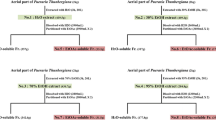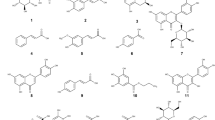Abstract
Piceid (5,4′-dihydroxystilbene-3-O-β-D-glucopyranoside) is one of the stilbenes found in Polygonum cuspidatum. Previous studies have shown that this compound has little effect on tyrosinase inhibition when compared with other stilbenes in a cell-free tyrosinase assay. Furthermore, its role for melanogenesis in melanocytes is relatively unknown. In melanocytes, piceid inhibits tyrosinase activity and melanin production in a concentration-dependent manner. To explore the action of piceid on melanogenesis, we studied its effect on several key cellular enzymes and a transcriptional factor known to be involved in melanogenesis, including: tyrosinase, tyrosinase-related protein 1, tyrosinase-related protein 2, and microphthalmia-associated transcription factor. Interestingly, the effects of piceid on hypopigmentation and inhibition of tyrosinase activity were better than those of arbutin, which is well known to inhibit melanin formation in melanocytes. In addition, piceid suppressed the mRNA and protein expression of the aforementioned enzymes and transcriptional factor in a concentration-dependent manner. In this regards, our results showed that piceid represents a safe and new candidate for a skin-lightening agent.
Similar content being viewed by others
References
Aksan, I. and Goding, C. R., Targeting the microphthalmia basic helix-loop-helix-leucine zipper transcription factor to a subset of E-box elements in vitro and in vivo. Mol. Cell. Biol., 18, 6930–6938 (1998).
Bennett, D. C., Cooper, P. J., and Hart, I. R., A line of nontumorigenic mouse melanocytes, syngeneic with the B16 melanoma and requiring a tumour promoter for growth. Int. J. Cancer, 39, 414–418 (1987).
Bentley, N. J., Eisen, T., and Goding, C. R., Melanocytespecific expression of the human tyrosinase promoter: activation by the microphthalmia gene product and role of the initiator. Mol. Cell. Biol., 14, 7996–8006 (1994).
Bertolotto, C., Bille, K., Ortonne, J. P., and Ballotti, R., In B16 melanoma cells, the inhibition of melanogenesis by TPA results from PKC activation and diminution of microphthalmia binding to the M-box of the tyrosinase promoter. Oncogene, 16, 1665–1670 (1998a).
Bertolotto, C., Abbe, P., Hemesath, T. J., Bille, K., Fisher, D. E., Ortonne, J. P., and Ballotti, R., Microphthalmia gene product as a signal transducer in cAMP-induced differentiation of melanocytes. J. Cell Biol., 142, 827–835 (1998b).
Bertolotto, C., Busca, R., Abbe, P., Bille, K., Aberdam, E., Ortonne, J. P., and Ballotti, R., Different cis-acting elements are involved in the regulation of TRP1 and TRP2 promoter activities by cyclic AMP: pivotal role of M boxes (GTCATGTGCT) and of microphthalmia. Mol. Cell Biol., 18, 694–702 (1998c).
Boissy, R. E., Melanosome transfer to and translocation in the keratinocyte. Exp. Dermatol., 12Suppl 2, 5–12 (2003).
Fang, D., Kute, T., and Setaluri, V., Regulation of tyrosinaserelated protein-2 (TYRP2) in human melanocytes: relationship to growth and morphology. Pigment Cell Res., 14, 132–139 (2001).
Gilchrest, B. A. and Eller, M. S., DNA photodamage stimulates melanogenesis and other photoprotective responses. J. Investig. Dermatol. Symp. Proc., 4, 35–40 (1999).
Hearing, V. J. and Jimenez, M., Analysis of mammalian pigmentation at the molecular level. Pigment Cell Res., 2, 75–85 (1989).
Hearing, V. J. and Tsukamoto, K., Enzymatic control of pigmentation in mammals. FASEB J., 5, 2902–2909 (1991).
Hodgkinson, C. A., Moore, K. J., Nakayama, A., Steingrimsson, E., Copeland, N. G., Jenkins, N. A., and Arnheiter, H., Mutations at the mouse microphthalmia locus are associated with defects in a gene encoding a novel basichelix-loop-helix-zipper protein. Cell, 74, 395–404 (1993).
Hughes, A. E., Newton, V. E., Liu, X. Z., and Read, A. P., A gene for Waardenburg syndrome type 2 maps close to the human homologue of the microphthalmia gene at chromosome 3p12–p14.1. Nat. Genet., 7, 509–512 (1994).
Jayatilake, G. S., Jayasuriya, H., Lee, E. S., Koonchanok, N. M., Geahlen, R. L., Ashendel, C. L., McLaughlin, J. L., and Chang, C. J., Kinase inhibitors from Polygonum cuspidatum. J. Nat. Prod., 56, 1805–1810 (1993).
Kim, Y. M., Yun, J., Lee, C. K., Lee, H., Min, K. R., and Kim, Y., Oxyresveratrol and hydroxystilbene compounds. Inhibitory effect on tyrosinase and mechanism of action. J. Biol. Chem., 277, 16340–16344 (2002).
Kobayashi, T., Urabe, K., Winder, A., Jimenez-Cervantes, C., Imokawa, G., Brewington, T., Solano, F., Garcia-Borron, J. C., and Hearing, V. J., Tyrosinase related protein 1 (TRP1) functions as a DHICA oxidase in melanin biosynthesis. EMBO J., 13, 5818–5825 (1994).
Kobayashi, T., Vieira, W. D., Potterf, B., Sakai, C., Imokawa, G., and Hearing, V. J., Modulation of melanogenic protein expression during the switch from eu- to pheomelanogenesis. J. Cell Sci., 108, 2301–2309 (1995).
Leu, Y. L., Hwang, T. L., Hu, J. W., and Fang, J. Y., Anthraquinones from Polygonum cuspidatum as tyrosinase inhibitors for dermal use. Phytother. Res., 22, 552–526 (2008).
Levy, C., Khaled, M., and Fisher, D. E., MITF: master regulator of melanocyte development and melanoma oncogene. Trends Mol. Med., 12, 406–414 (2006).
Likhitwitayawid, K., Stilbenes with tyrosinase inhibitory activity. Curr. Sci., 94, 44–52 (2008).
Maeda, K. and Fukuda, M., Arbutin: Mechanism of its depigmenting action in human melanocyte culture. J. Pharmacol. Exp. Ther., 276, 765–769 (1996).
Ohguchi, K., Tanaka, T., Ito, T., Iinuma, M., Matsumoto, K., Akao, Y., and Nozawa, Y., Inhibitory effects of resveratrol derivatives from dipterocarpaceae plants on tyrosinase activity. Biosci. Biotechnol. Biochem., 67, 1587–1589 (2003a).
Ohguchi, K., Tanaka, T., Kido, T., Baba, K., Iinuma, M., Matsumoto, K., Akao, Y., and Nozawa, Y., Effects of hydroxystilbene derivatives on tyrosinase activity. Biochem. Biophys. Res. Commun., 307, 861–863 (2003b).
Okazaki, K., Uzuka, M., Morikawa, F., Toda, K., and Seiji, M., Transfer mechanism of melanosomes in epidermal cell culture. J. Invest. Dermatol., 67, 541–547 (1976).
Price, E. R., Horstmann, M. A., Wells, A. G., Weilbaecher, K. N., Takemoto, C. M., Landis, M. W., and Fisher, D. E., alpha-Melanocyte-stimulating hormone signaling regulates expression of microphthalmia, a gene deficient in Waardenburg syndrome. J. Biol. Chem., 273, 33042–33047 (1998).
Song, T., Chen, C., Yang, N., Fu, C., Chang, Y., and Chen, C., The correlation of in vitro mushroom tyrosinase activity with cellular tyrosinase activity and melanin formation in melanoma cells A2058. J. Food and Drug Anal., 17, 156–162 (2009).
Steingrimsson, E., Moore, K. J., Lamoreux, M. L., Ferre-D’Amare, A. R., Burley, S. K., Zimring, D. C., Skow, L. C., Hodgkinson, C. A., Arnheiter, H., Copeland, N. G. et al., Molecular basis of mouse microphthalmia (mi) mutations helps explain their developmental and phenotypic consequences. Nat. Genet., 8, 256–263 (1994).
Tachibana, M., Evidence to suggest that expression of MITF induces melanocyte differentiation and haploinsufficiency of MITF causes Waardenburg syndrome type 2A. Pigment Cell Res., 10, 25–33 (1997).
Tassabehji, M., Newton, V. E., and Read, A. P., Waardenburg syndrome type 2 caused by mutations in the human microphthalmia (MITF) gene. Nat. Genet., 8, 251–255 (1994).
Teguo, P. W., Decendit, A., Vercauteren, J., Deffieux, G., and Merillon, J.-M., Trans-resveratrol-3-O-β-glucoside (piceid) in cell suspension cultures of Vitis vinifera. Phytochemistry, 42, 1591–1593 (1996).
Virador, V. M., Kobayashi, N., Matsunaga, J., and Hearing, V. J., A standardized protocol for assessing regulators of pigmentation. Anal. Biochem., 270, 207–219 (1999).
Widlund, H. R. and Fisher, D. E., Microphthalamia-associated transcription factor: a critical regulator of pigment cell development and survival. Oncogene, 22, 3035–3041 (2003).
Yasumoto, K., Yokoyama, K., Takahashi, K., Tomita, Y., and Shibahara, S., Functional analysis of microphthalmiaassociated transcription factor in pigment cell-specific transcription of the human tyrosinase family genes. J. Biol. Chem., 272, 503–509 (1997).
Yavuzer, U., Keenan, E., Lowings, P., Vachtenheim, J., Currie, G., and Goding, C. R., The Microphthalmia gene product interacts with the retinoblastoma protein in vitro and is a target for deregulation of melanocyte-specific transcription. Oncogene, 10, 123–134 (1995).
Yokoyama, K., Suzuki, H., Yasumoto, K., Tomita, Y., and Shibahara, S., Molecular cloning and functional analysis of a cDNA coding for human DOPAchrome tautomerase/tyrosinase-related protein-2. Biochim. Biophys. Acta, 1217, 317–321 (1994).
Author information
Authors and Affiliations
Corresponding author
Rights and permissions
About this article
Cite this article
Jeong, E.T., Jin, M.H., Kim, MS. et al. Inhibition of melanogenesis by piceid isolated from Polygonum cuspidatum . Arch. Pharm. Res. 33, 1331–1338 (2010). https://doi.org/10.1007/s12272-010-0906-x
Received:
Revised:
Accepted:
Published:
Issue Date:
DOI: https://doi.org/10.1007/s12272-010-0906-x




